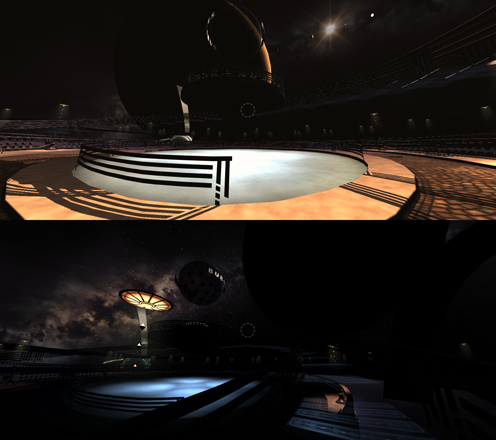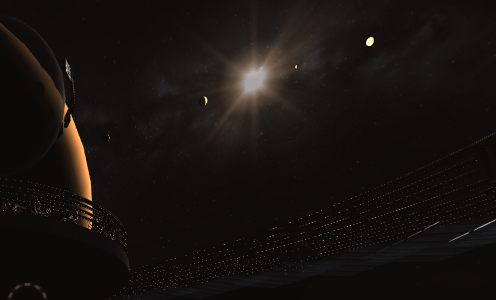The trouble with the solar system is, it’s big.
Really big.
So I was working on getting Tinselfly to understand the concept of interplanetary travel. I want it to be smooth and seamless; I want the player to really feel the distances involved here. I want the player to feel small. This is sort of an extension of some stuff I was doing last year.
In short: you can’t just model this stuff and have it work. You have to use some camera tricks. So I came up with a plan. It was a clever, workable plan inspired by the effects in The Lord of the Rings, and I was halfway through it when I realized the other half might not be worth doing.
Here are the parts I finished:
- You are orbiting a small moon, the big screen-filling, sun-blotting sphere in the images above. Its size is realistic.
- The moon is orbiting a gas giant, which in turn has other moons, all of which are realistically sized.
- You can see four small planets orbiting the sun in the top image; their positions are realistic.
But here’s a problem that I’m choosing to leave in:
- The sizes of the four small planets you can see near the sun are not remotely realistic.
You’re viewing the bodies in this solar system as if the planets are reasonably sized, but the planets (including yours) are all 1000 times closer to the sun than they should be.
The four little planets above? Are shown 1000 times bigger than they would be in real life. It was part of my plan, to store everything using a compressed scale in my scene, and kind of inflate it all when the game was actually running. And I stopped just short of implementing that inflation part.
Looking at this detail image here, you can see that each planet has a different phase, like the real Moon does. The planet on the left is reddish and a crescent. The planets in the middle are half moons. The one on the right is almost full. You can tell these are spheres, being lit by the sun, with different sizes and colors.
In short, you can tell they’re planets. Which, realistically, you could not do. Realistically, they should look kinda like particularly bright, untwinkling stars.
Looking up at the night sky never, ever, made me feel small and insignificant, because reality does a terrible job of communicating to the viewer what they’re actually looking at. And I don’t see it as my job to have space be big. It’s my job to communicate that space is big.
Rather by accident, looking up at these planets in-game makes me feel small in a way that reality does not, because it’s all on a scale I can start to comprehend — and I start to comprehend just how far I am from really being able to grasp how big that scale is. So I think I’ll leave this mistake, this unfinished camera trick, in.
For the same reason, I have made the plane of the solar system here line up exactly with the plane of the galaxy, with lines up exactly with the plane of the planetary system you’re in. Again, not entirely realistic, but seeing everything lined up like that — and seeing it all move unrealistically fast — cements this idea that you’re part of this system of spheres spinning around other, larger spheres, spinning around ever larger objects.
And watching all this makes me feel really, really, tiny. Which is what I’m going for here.

